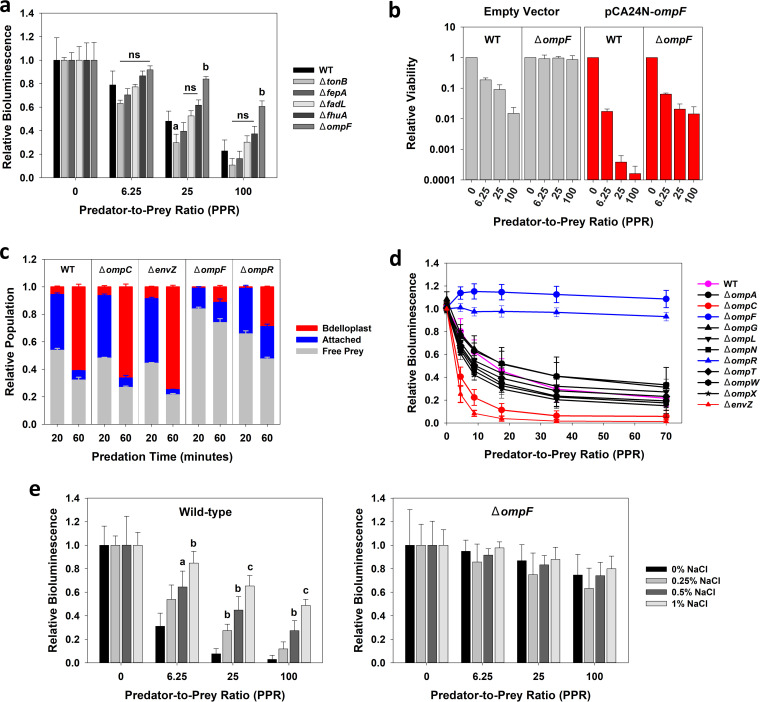FIG 1.
Loss of OmpF in E. coli significantly impacts predation rates. (a) Predation of various phage receptor mutants in E. coli strain BW25113. The relative bioluminescence results (determined at 1 h) show that predation was severely delayed when ompF was knocked out. Statistical significance was determined against the wild-type (WT) E. coli BW25113 response. ns, not significant; a, P < 0.05; b, P < 0.01. Error bars show standard deviations (SD) (n = 3). (b) Expression of a functional ompF gene increases predation rates. Complementation of the ΔompF knockout led to similar predation rates as in the wild-type E. coli BW25113, while overexpression of the ompF gene in the wild-type E. coli BW25113 background led to significantly better predation rates. The viability was measured after 1 h of predation. Error bars show SD (n = 3). (c) Loss of ompF hinders attachment of the predator to the prey and delays bdelloplast development. The numbers of each population (i.e., free prey, prey having a predator attached, or bdelloplast) were determined for each genetic background at 20 and 60 min after initiating predation. The results show that loss of ompC or envZ slightly increased attachment and bdelloplast formation, while loss of ompF or ompR had the opposite impact at both time points. An average of >100 bacterial cells was used to analyze each independent sample. Error bars show SD (n = 3). (d) Impact of other outer membrane proteins on predation rates. Eleven different isogenic mutants (Table S1) were evaluated based on their relative bioluminescence values. The loss of none of these genes had a significant impact on predation rates other than those related to the EnvZ-OmpR two-component regulatory system, i.e., envZ, ompR, ompC, and ompF. Error bars show SD (n = 3). (e) Growth of E. coli at higher osmolalities reduces its predation rate. The osmolality of the growth medium was adjusted based on the NaCl content (0 to 1% [wt/vol]). The results show that growth of wild-type E. coli BW25113/pGen-luxCDABE at higher osmolalities decreased its predation (left), while the absence of a functional ompF gene prevented this; i.e., each culture was predated equally regardless of the growth medium’s osmolality (right). Statistical significance was determined against the 0% NaCl culture responses. a, P < 0.05; b, P < 0.01; c, P < 0.001. Error bars show SD. (n = 3).

